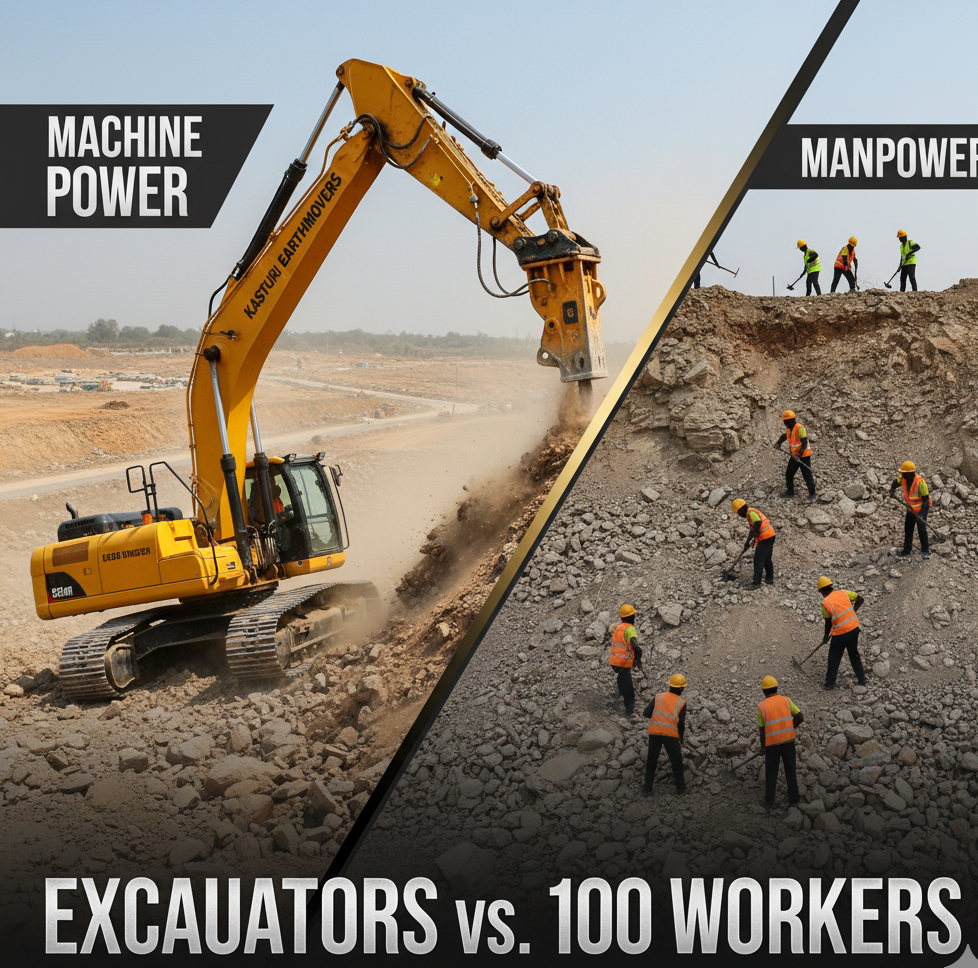Imagine this, you live in the 12th century, and a magnificent monument is being built. Over a 100 workers are working under the scorching heat of the sun. They have toiled for years, digging the ground, carrying dug-up soil from the site elsewhere, and carrying heavy slabs of stone from the quarry to the site. Now, what if excavators drive up to the site of the monument?
What would happen?
In the blog below, we explore how far we have come from utilizing manpower to machine power.
Before Excavators: When Manpower Meant Breaking Backs
Since the dawn of human civilization, humans have built humongous monuments like the pyramids of Egypt, the Colosseum in Rome, and the Taj Mahal in India. These monuments took a lot of effort in terms of human resources to build. It is estimated that 1 lakh people were employed for the construction of the Colosseum. While to build the Taj Mahal, 20,000 people were employed.
Armed with pickaxes, pulleys and other hand tools, these people spent years building the monuments. It took away a significant part of valuable time away from their lives. They could’ve spent this time enriching their lives, but they did not.
In addition, the nature of soil, stone, water and other natural agents presented numerous difficulties in their work. Working with these natural forces meant a significant amount of strength, time and effort went into digging, quarrying, breaking and carrying all these materials.
But things started to change with the entry of machines.
The Industrial Revolution ushered in a new era and changed the way humans had performed manual work. Railways, cars and buses started to fare on the roads. Trucks and heavy hauling equipment reduced the need for a large amount of manpower to be involved in construction works. Construction Equipment transformed from pickaxes and pulleys to drillers, stone crushers and most importantly, excavators.
The Rise of the Excavators
The first excavator was formally known as the Otis steam excavator. It was the first mobile, land-based power shovel. This was a major invention for the construction industry. For the first time in history, a machine could manage to excavate almost 10 times the amount in the same time frame.
The design by the American Benjamin Holt in 1901 paved the way for modern excavators. These machines today combine power, precision and efficiency into a machine. These machines perform with the effectiveness of almost 100 workers.
In addition to standard excavators, long boom excavators perform operations that were previously impossible to perform by humans. River desilting, deep excavations and port maintenance are now being performed by long boom excavators.
For instance, as per data, an excavator can excavate 8100 cubic feet of dirt and soil per day. When compared to this, humans can only excavate 216 cubic feet. The size of the material, the speed with which the excavation is done and transported is vastly different from that done by humans..
Excavators vs. 100 Workers: The Real Comparison
1. Speed & Efficiency: The machines work continuously without fatigue — completing projects 8–10x faster.
2. Precision: Advanced excavators minimize rework and waste with hydraulic precision.
3. Safety: Excavators reduce risk in hazardous sites like trenches, flood zones, and landslides.
4. Cost-Effectiveness: Hiring workers can be expensive and time-consuming. Instead, an excavator rental service like Kasturi Earthmovers offers cost-effective rental plans tailored to your project.
The Limits of Excavators
However, after all the talk about how excavators can perform the tasks of 100 humans, there is a need to understand that humans still need to oversee the actions earthmoving equipments. An excavator cannot operate without trained operators and site planning and humans are better suitable to judge these tasks.
In addition, excavators still need to tackle agents of nature such as floods, unstable soil and rocks, mudslides, steep gradients and whatnot. Expert human supervision is crucial for these machines to perform.
Excavators amplify human ability to manipulate the landscapes around them. They cannot ever replace humans.
Harmony Over Competition
Excavators represent human innovation that collaborates with nature, not conquers it. Sustainable excavation practices, low-emission engines, and fuel-efficient hydraulics reduce environmental impact.
Smart rental models by excavator rental services like Kasturi Earthmovers ensure resource efficiency.
Through smart rental models, Kasturi Earthmovers ensures that construction companies have access to modern, well-maintained excavators on rent without the burden of ownership.
Conclusion
The balance between machine power and manpower represents progress. Excavators help humans build faster, safer, and smarter — proving that the combination of human intellect and machine efficiency creates the foundation for modern infrastructure.
At Kasturi Earthmovers, we provide excavators on rent across India — from standard excavator to long boom and hydraulic models. Our rental services ensure flexibility, affordability, and maintenance-free operations for every project.
Contact Us for Excavator Rental Services
Kasturi Earthmovers



